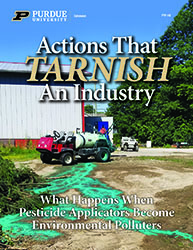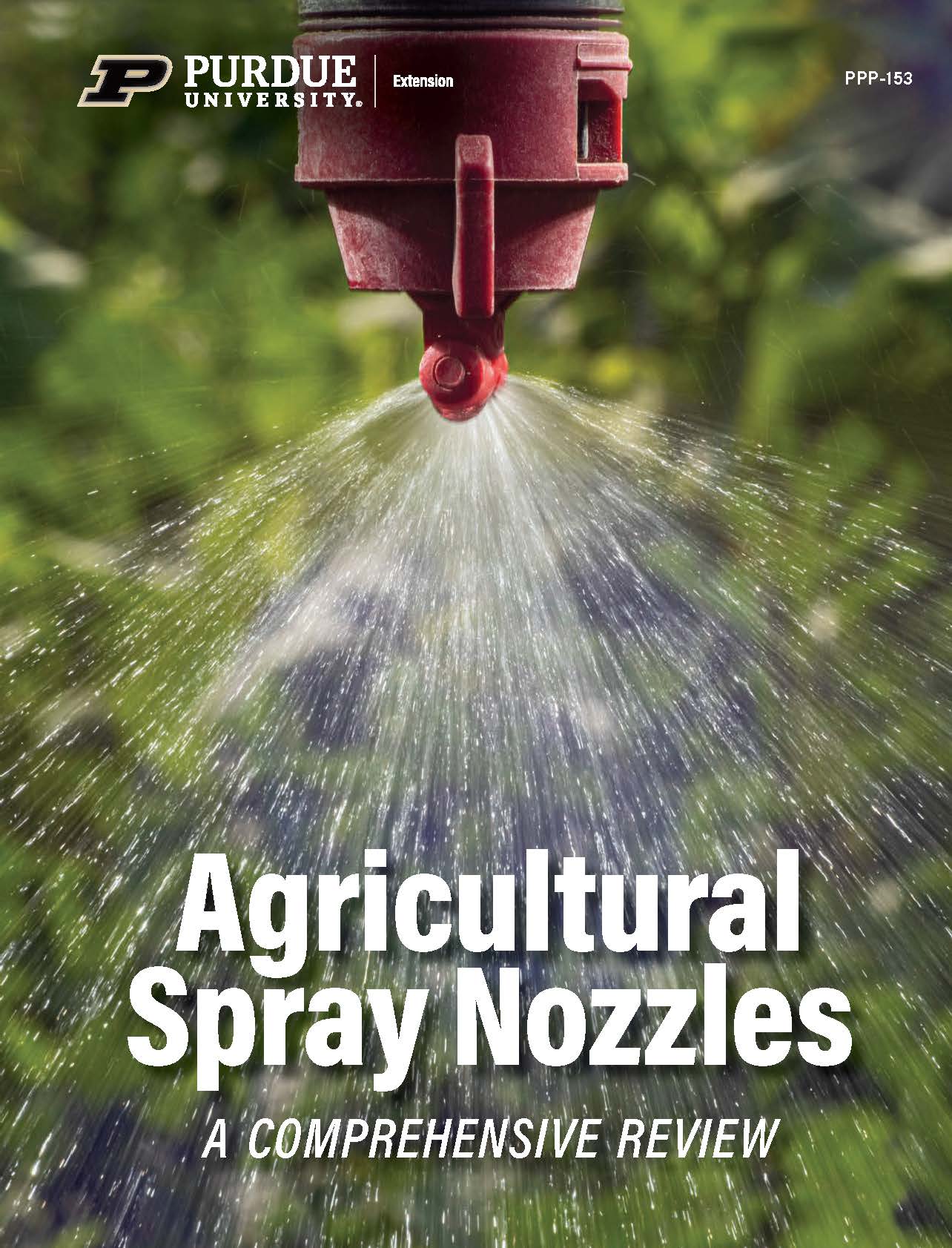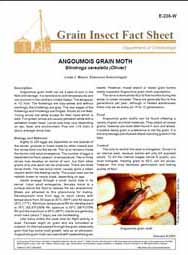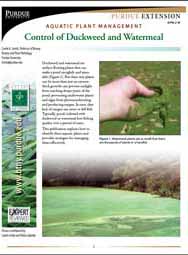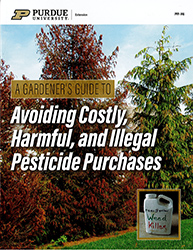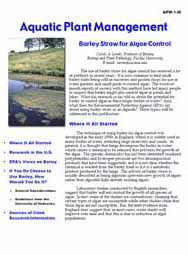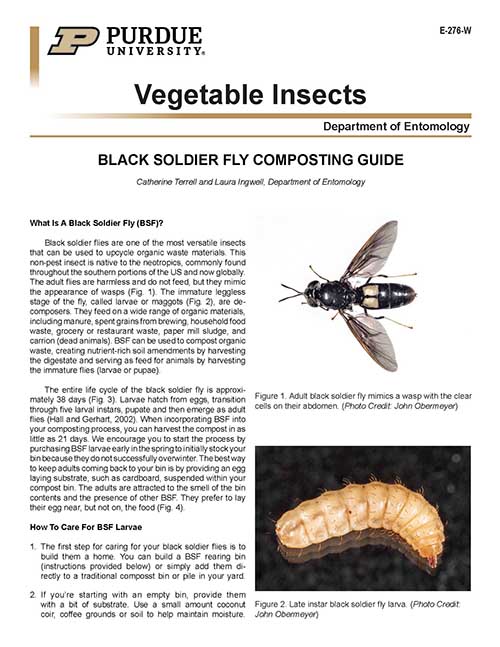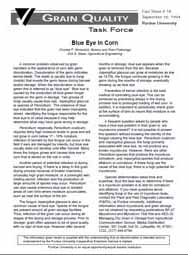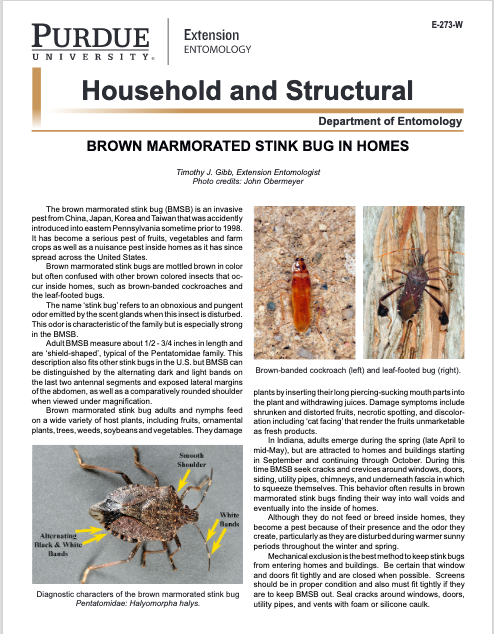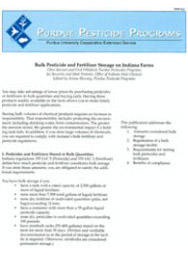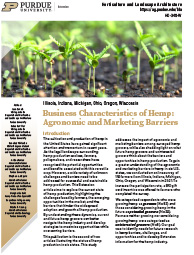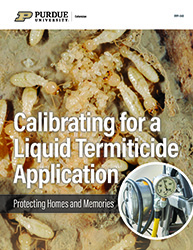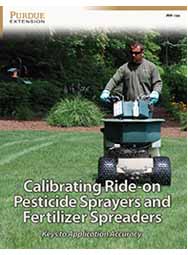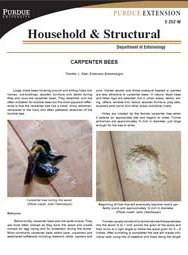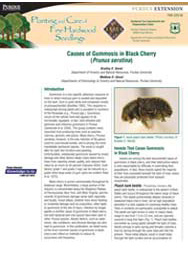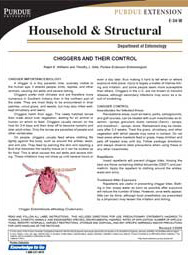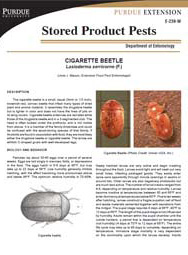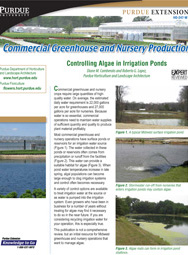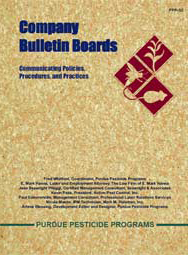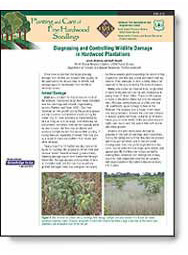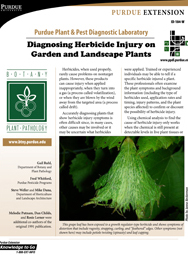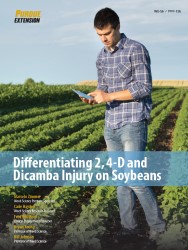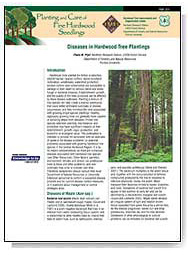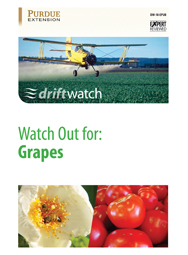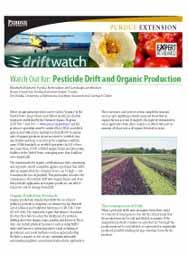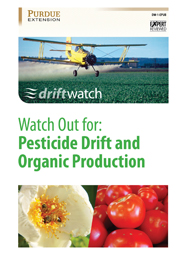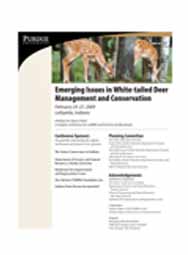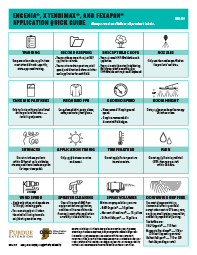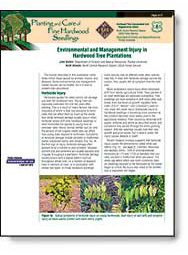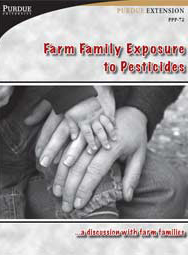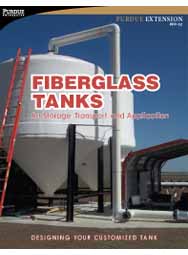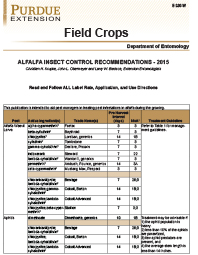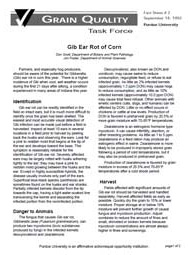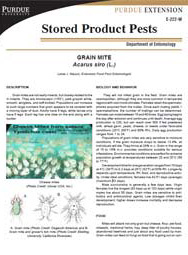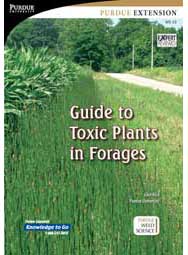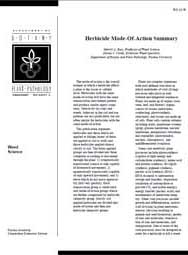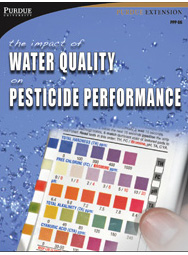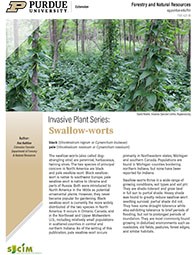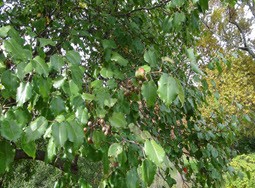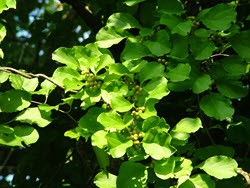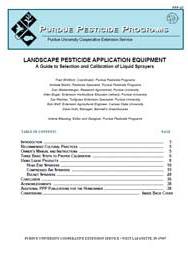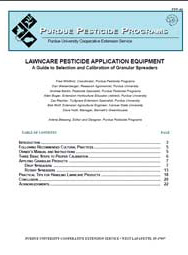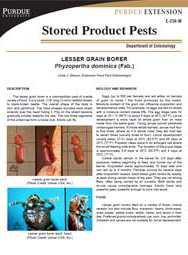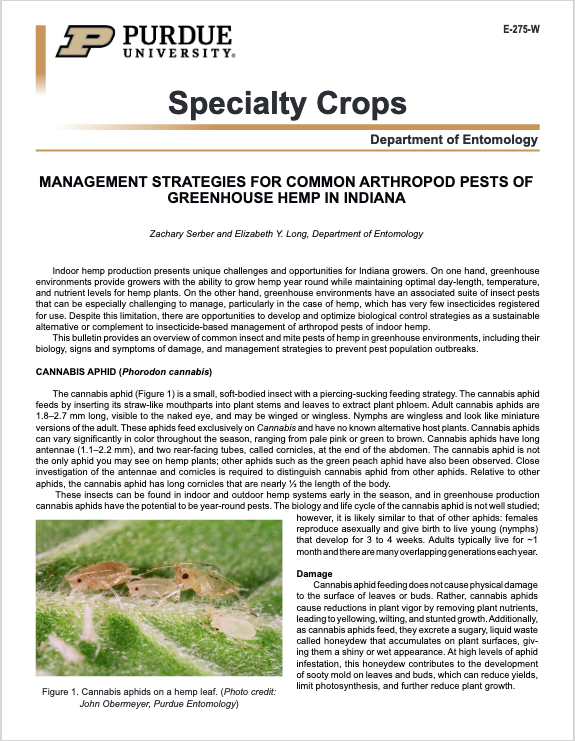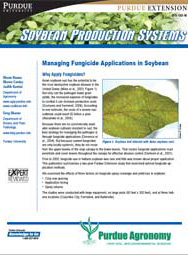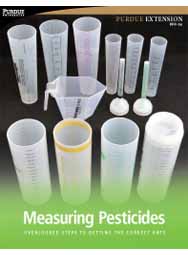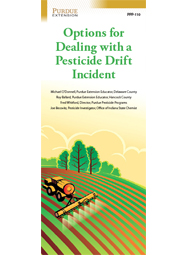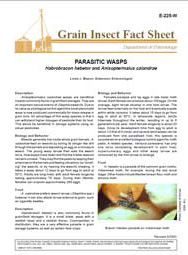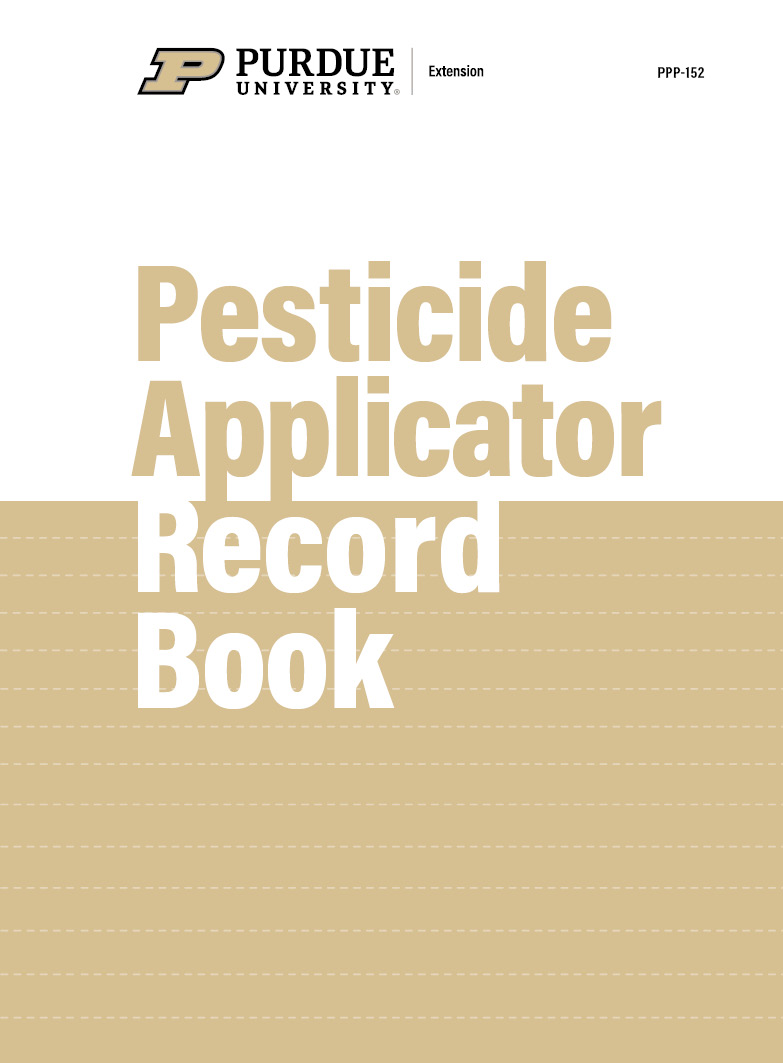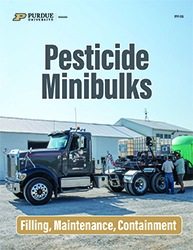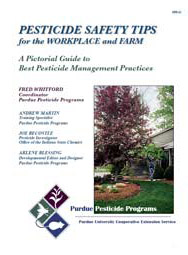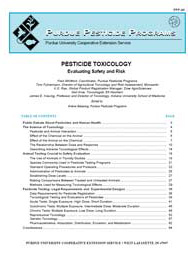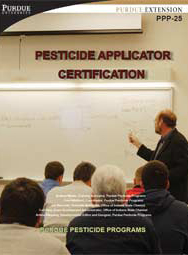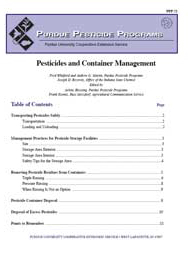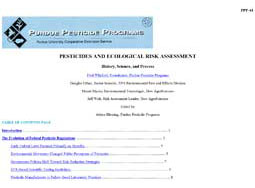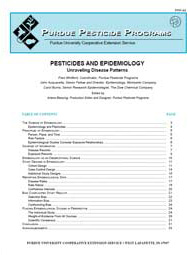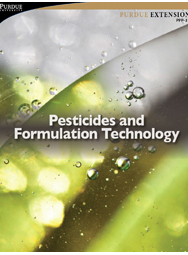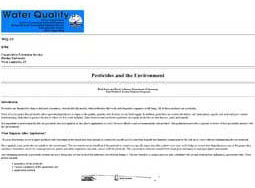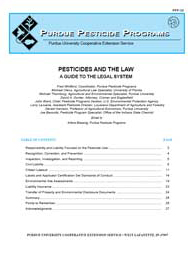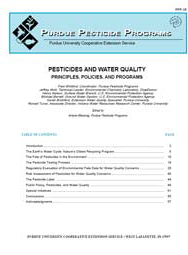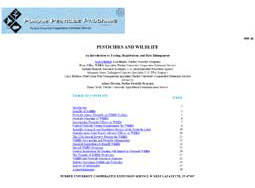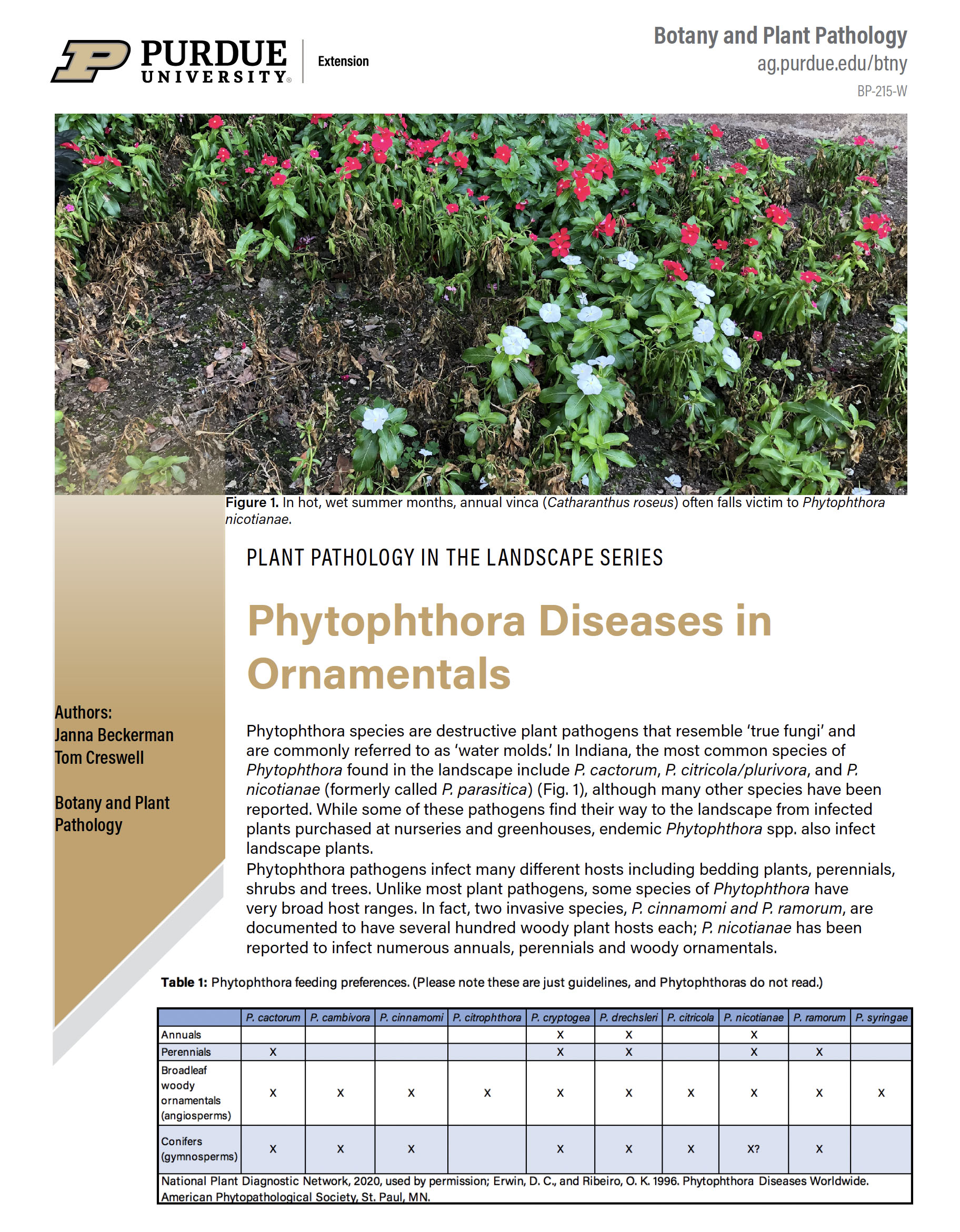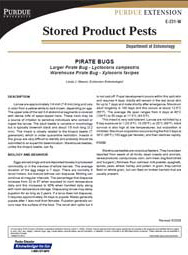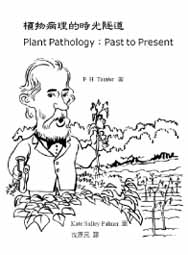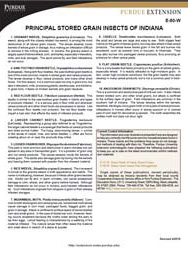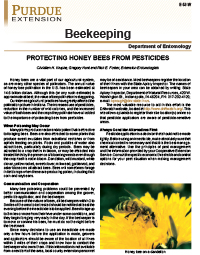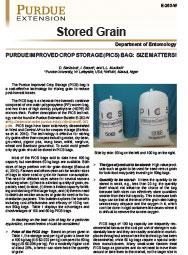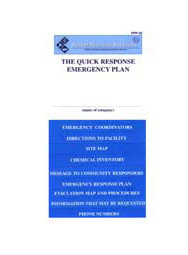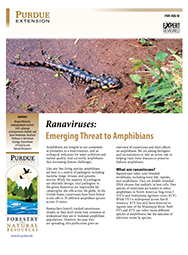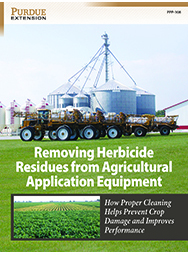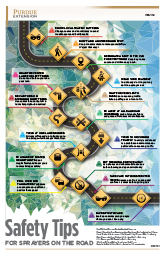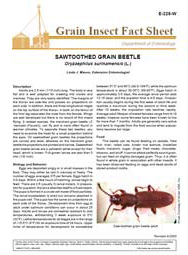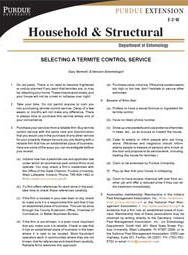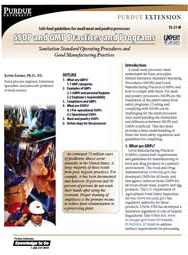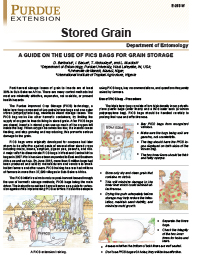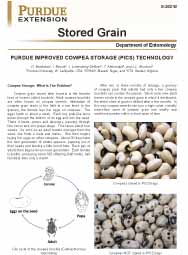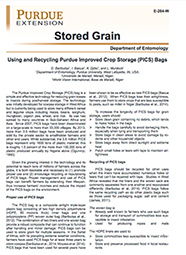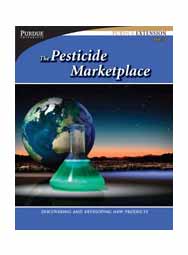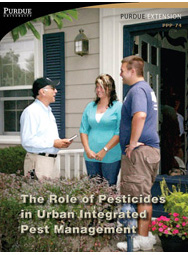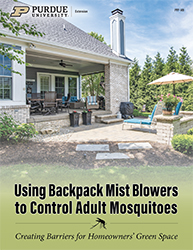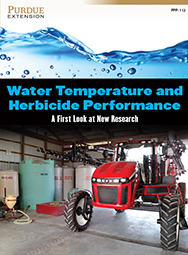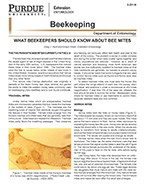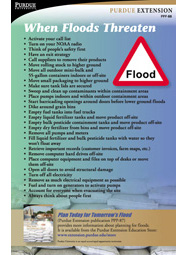Pest Management
Other Pest Management
Pesticide labels inform users how to effectively control pests. When used properly, the pesticide product should not harm the applicator, public, or environment. Labels also inform users how to dispose of leftover pestic...
Adjuvants and the Power of the Spray Droplet: Improving the Performance of Pesticide Applications
This publication examines how the various components of a pesticide application work (water, pesticide molecules, application equipment). It then describes how adjuvants can enhance pesticide performance and protect agai...
Agricultural Spray Nozzles: A Comprehensive Review
As we explore and implement these new technologies, it is important not to overlook advances in hydraulic nozzle technology and to acknowledge the critical role they play in the application process. In general, a nozzle ...
Angoumois grain moth can be a pest of corn in the field and storage. This publication describes this pest and recommends methods for controlling it.
Format: PDF.
Pages: 2.
This publication addresses the benefits of having aquatic vegetation and problems it can cause. The publication also includes an aquatic plant identification guide with color photos along with methods to control aquatic ...
Aquatic Plant Management: Control of Duckweed and Watermeal
Duckweed and watermeal are surface-floating plants that can make a pond unsightly and unusable, and can indirectly harm fish. This publication explains how to identify these aquatic plants and provides strategies for man...
Aquatic Plant Management: Identifying and Managing Aquatic Vegetation
Vegetation is an important part of any aquatic system, but sometimes, aquatic plants can get out of control and create problems. This publication explains the benefits of aquatic vegetation, describes the problems posed ...
Avoid Tank Mixing Errors: A Guide to Applying the Principles of Compatibility and Mixing Sequence
This publication describes how several factors influence product compatibility. It is important to understand these basic factors (including formulation, tank mixing order, and carrier type) to help you effectively co...
Avoiding Costly, Harmful, and Illegal Pesticide Purchases
Many homeowners struggle with maintaining their lawns, flower and vegetable gardens, landscapes, wooded areas, and water features. Insects and diseases are an occasional nuisance, but weeds are a constant problem. Despit...
Barley Straw for Algae Control
The use of barley straw for algae control has received a lot of publicity in recent years. It is now common to find small barley bales being sold in nurseries and garden shops for use in water gardens and small pools to ...
Black Soldier Fly Composting Guide
This project is a guide to integrating Black Soldier Flies into a composting process. The goal of increasing organic matter recycling, generating soil amendments, and protein for small livestock. Impact: reduce input cos...
This one-page publication entitled, "Blue Eye in Corn" discusses a type of germ discoloration. Blue eye in corn is usually due to fungi in the germ tissue. Occuring during harvest, blue eye indicates that grain has be...
Brown Marmorated Stink Bug In Homes
The brown marmorated stink bug (BMSB) is an invasive pest from China, Japan, Korea and Taiwan that was accidently introduced into eastern Pennsylvania sometime prior to 1998. It has become a serious pest of fruits, veget...
Bulk Pesticide & Fertilizer Storage on Indiana Farms
You may take advantage of lower prices by purchasing pesticides or fertilizers in bulk quantities and buying early. Having these products readily available on the farm allows you to make timely pesticide and fertilizer a...
Business Characteristics of Hemp: Agronomic and Marketing Barriers
Navigating the hemp industry, even as production in the U.S. is increasing, can be complicated. This Extension publication by Purdue University researchers highlights the challenges and barriers that hemp growers in five...
Calibrating for a Liquid Termiticide Application
Pesticides can protect crop yields from plant pests, human health from mosquito-borne diseases, and pond ecosystems from the further spread of invasive weeds. One often overlooked (but important) benefit of pesticides is...
Calibrating Ride-on Pesticide Sprayers and Fertilizer Spreaders: Keys to Application Accuracy
This publication addresses specific procedures for separately calibrating the pesticide sprayer and the fertilizer spreader of ride-on equipment. The goal is to ensure proper application to optimize performance.
Large black bees hovering around and drilling holes into homes, out-buildings, wooden furniture and decks during May and June are carpenter bees. They resemble, and are often mistaken for bumble bees but the most apparen...
This publication provides a description of the cigarette beetle. In addition, facts are provided about the biology, behavior and food preferences....
Commercial Greenhouse and Nursery Production: Controlling Algae in Irrigation Ponds
Because water is so essential, commercial greenhouse and nursery operations need to maintain water supplies of sufficient quantity and quality to produce plant material profitably. This publication is not a comprehensive...
Company Bulletin Boards Communicating Policies, Procedures, and Practices
The employee bulletin board should be an official site where the employer communicates policies and procedures to employees. Maintenance of bulletin boards tends to become a "back burner" item when seemingly more impor...
Compendium Of Herbicide Adjuvants, 2016 Edition
This is a joint publication of Purdue Extension and Southern Illinois University. This is the 13th edition of the biennial publication, which was previously published by Southern Illinois. This edition contains 780 en...
Diagnosing and Controlling Wildlife Damage
Once trees are planted and begin growing, damage from wildlife can threaten their quality. In this 8-page publication (PDF) we discuss how to identify and minimize loss and manage injury caused by wildlife to hardwoods. ...
Diagnosing Herbicide Injury on Garden Landscape Plants
Herbicides, when used properly, rarely cause problems on nontarget plants, but they can sometimes injure other plants. This publication examines the common causes of herbicide injury and how to avoid them....
Differentiating 2, 4-D and Dicamba Injury on Soybeans
This publication discusses and describes the differences between 2,4-D and dicamba symptomology on soybeans. The objective of this publication is to help farmers and Ag professionals to accurately diagnose herbicide o...
Differentiating 2, 4-D and Dicamba Injury on Soybeans
This publication discusses and describes the differences between 2,4-D and dicamba symptomology on soybeans. The objective of this publication is to help farmers and Ag professionals to accurately diagnose herbicide o...
Disease Management Strategies for Horticultural Crops: Using Organic Fungicides
When confronted with a disease, many say they prefer to use organic products because they are more environmentally friendly. Others say they just want to use a product that works, regardless of the ecological impact. Man...
Diseases in Hardwood Tree Plantings
This publication provides the landowners with an overview of some of the disease problems (or potential problems) associated with growing hardwood tree species in the Central Hardwood Region....
Driftwatch: Watch Out for Grapes
Pesticide drift can severely damage non-target crops. This Driftwatch publication addresses drift in grapes. It examines products of special concern, injury symptoms and potential impact, and alternatives and ways to avo...
Driftwatch: Watch Out for Grapes
Pesticide drift can severely damage non-target crops. This Driftwatch publication addresses drift in grapes. It examines products of special concern, injury symptoms and potential impact, and alternatives and ways to avo...
Driftwatch: Watch Out for Pesticide Drift and Organic Production
The requirements for organic certification are time-consuming and expensive. And if a neighbor applies a pesticide that drifts onto an organic field, the economic losses can be high. This publication describes the conseq...
Driftwatch: Watch Out for Pesticide Drift and Organic Production
The requirements for organic certification are time-consuming and expensive. And if a neighbor applies a pesticide that drifts onto an organic field, the economic losses can be high. This publication describes the conseq...
Emerging Issues in White-tailed Deer Management and Conservation
White-tailed Deer have the ability to change the structure and composition of forests throughout their range. This coupled with their proliferation have led some to term the whitetail an ecological keystone species. Howe...
Engenia, Xtendimax, And FeXapaŽ Application Quick Guide and Required Records for Applications
One side of this handout provides a quick guide for applying Engenia, Xtendimax, and FeXapan products to dicamba-resistant crops. The other side is a required record-keeping form for making those applications. The pri...
Environmental and Management Injury in Hardwood Tree Plantations
Herbicides applied for weed control can damage and even kill hardwood trees. This publication discusses recovery of loss from herbicide injury, soil compaction, frost damage, frost cracks, dieback, sunscald, ice, salt, f...
Farm Family Exposure to Pesticides: A Discussion with Farm Families
This publication addresses questions and concerns regarding pesticide risks and explains how risk is evaluated; it directs you to additional sources of information on pesticide toxicity. Data from the Farm Family Exposur...
Fiberglass Tanks for Storage, Transport, and Application: Designing Your Customized Tank
This publication examines fiberglass storage tanks; their benefits; what to consider before buying them; and how to properly use, install, and maintain them. This publication also is a companion to Poly Tanks for Farms a...
Field Crops: Alfalfa Insect Control Recommendations
This publication is an aid for pest managers in treating insect pest infestations in alfalfa during the growing season.
Format: PDF.
Pages: 6.
Language:...
Forest Pest Control Perspective
This publication discusses pest control in forests and management of forest pests. Pesticides, herbicides, insecticides, rodenticides and fungicides are discussed. ...
This grain quality fact sheet has information about identifying Gib ear rot, its danger to animals, and its effects on harvest and storage....
This publication provides a description of grain mites. In addition, facts are provided about the biology, behavior, food preferences and control methods for grain mites....
Grain Mite Infestation: Prevention and Control
This grain quality fact sheet has information about infestation, prevention, and control of moderate infestation of grain mites....
Guide to Toxic Plants in Forages
Several plants in our pastures can be toxic to horses and cattle. The best way to assure that forage is as safe as possible is to keep these plants out of your fields and pastures. Doing this, requires proper weed i...
This publication provides a description of the hairy fungus beetle, a pest of grain that feeds on mold. In addition, facts are provided about the biology, behavior and food preferences of the beetle....
Impact of Water Quality on Pesticide Performance
The quality of the water used to spray the product is one factor that doesn't get much attention for effective pesticide applications . Research clearly shows that the quality of water used for spraying can affect how pe...
This publication provides a description of the Indianmeal moth. In addition, facts are provided about the biology, behavior and food preferences of the Indianmeal moth....
Invasive Plant Series - Tree of Heaven, Ailanthus altissima
Tree-of-heaven is a serious threat as an invasive species in many habitats or untended areas. It can reach 80 feet or more, its growth rate outpaces most native tree species, and wind scatters seeds that female trees pro...
Invasive Plant Series: Swallow-worts
Black and pale Swallow-wort are non-native perennial, herbaceous, twining vines. Not yet well established in Indiana, the vines are highly invasive and grow rapidly, quickly twining around, climbing and overwhelming neig...
Invasive Plant Species: Callery Pear
Invasive plant species can damage woodlands and wildlife habitat areas. This video will familiarize you with Callery pear, an exotic invasive tree that is moving from ornamental plantings to fields and woodlands. Learn h...
Invasive Plant Species: Oriental Bittersweet
Invasive plant species can damage woodlands and wildlife habitat areas. This video will familiarize you with Oriental bittersweet, an exotic invasive vine that is moving from ornamental plantings to fields and woodlands....
Invasive Plant Species: Wintercreeper
Invasive plant species can damage woodlands and wildlife habitat areas. This video will familiarize you with wintercreeper, an exotic invasive vine that is moving from ornamental plantings to fields and woodlands. Learn ...
Is This Pesticide On My Shelf Still Good?
You may have seen supermarket shoppers reaching to the back of the cooler for what they perceive to be the "freshest" milk. You are used to checking perishable foods (milk, eggs, meat, bread, juices, and more) for the ex...
Laminitis Caused by Black Walnut Wood Residues
Very small quantities of black walnut residue in horse bedding can result in laminitis. This publication discusses a growing problem in using horse bedding containing black walnut chips and strands....
Landscape Pesticide Application Equipment: A Guide to Selection and Calibration of Liquid Sprayers
Homeowners strive for beautiful and productive lawns, and sometimes, despite using good cultural practices, pests get the upper hand. When using pesticides to control pests it's important to follow procedures and know ho...
Lawncare Pesticide Application Equipment: A Guide to Selection and Calibration of Granular Spreaders
Not calibrating lawn application equipment is like placing a meal in an oven and setting the temperature randomly. If the over is too high, the food is overcooked; too low, and it undercooked. This publication describe...
The lesser grain borer is a pest that feeds on a variety of food. This publication provides a description and discusses its biology and behavior and the types of food it feeds on....
Management Strategies For Common Arthropod Pests of Greenhouse Hemp In Indiana
Indoor hemp production presents unique challenges and opportunities for Indiana growers. On one hand, greenhouse environments provide growers with the ability to grow hemp year round while maintaining optimal day-length,...
Measuring Pesticides: Overlooked Steps To Getting the Correct Rate.
This publication describes steps that pesticide applicators can take to correctly measure and mix products to improve results, save money, and enhance safety. Specifically, it will explain some common myths about measuri...
Mint Production and Pest Management in Indiana
This publication provides information about producing mint. Included is information about planting and maintenance, irrigation, harvesting and oil distillation. Pest maintenance is also discussed for weeds, diseases and ...
Offering Sound Pest Management Advice to the Public
This publication emphasizes the importance of providing sound pesticide advice to customers. Good diagnostic skills are essential. You personally must know and understand the behavior of various pests and have a working ...
Options for Dealing with a Pesticide Drift Incident
When any pesticide moves through the air away from the target site and onto someone else's property – known as pesticide drift – the pesticide can damage non-target crops, landscape plants, and gardens. Th...
This publication provides a description of parasitic wasps. Parasitic wasps are beneficial insects commonly found in grain/food storages. The publication provides facts about the biology, behavior and food preferences of...
Now that most states allow hemp to be grown, and more uses for hemp fiber are found, an increase in production may be ahead. Growers and policymakers will benefit from this publication, by a team of Purdue University res...
Pesticide Applicator Record Book
This publication is for certified private applicators to record applications of restricted use pesticides.
Click Free Download button for the fillable electronic version which is also print ready.
Supplemental sp...
Pesticide Minibulks - Filling, Maintenance, Containment
There is no doubt that agriculture has embraced minibulk use as a very cost-effective and efficient way of moving pesticides from retailers to farms. The convenience of bypassing many smaller containers and the lower pri...
Pesticide Safety Tips for the Workplace and Farm
This pictorial guide to best pesticide management practices provides information on how to safely handle and store pesticides at the workplace or farm. It is important to follow the label instructions for handling and st...
Pesticide Toxicology--Evaluating Safety and Risk
This publication is intended to foster a better understanding of the role of toxicology in the safety evaluation and registration for pesticides.
Language: English.
Pages: 67.
Pesticides and Applicator Certification
This publication discusses certification requirements and programs for individuals who will be using restricted-use pesticides or applying general-use products in commercial situations....
Pesticides and Container Management
Proper management of pesticide containers generally is a straightforward procedure, but it requires careful thought and a proper attitude. Appropriate transportation and storage of pesticides help protect the environment...
Pesticides and Ecological Risk Assessment
This publication provides background information on the process of risk assessment and the role it plays in pesticide registration. It is intended to foster a better understanding of ecological risk assessment procedures...
Pesticides and Environmental Site Assessments
Environmental assessments are now performed routinely at commercial pesticide and fertilizer application businesses, farms, golf courses, lawn care companies, pest control firms and other businesses. The purpose of this ...
Understanding a few basic epidemiological concepts and methods helps comprehend epidemiological findings in scientific journals, media accounts and government documents. The intent of this publication is to provide an ov...
Pesticides and Fleet Vehicles Transporting Pesticides Safely
The care that you devote to maintaining your fleet goes a long way in conveying your commitment to quality service. This publication discusses the importance of vehicle maintenance, safe driving practices and how to resp...
Pesticides and Formulation Technology
This publication explains the benefits and problems associated with the various pesticide formulations. It also can be used to construct a planning or decision-making model for the proper selection of a formulation in a...
Pesticides and Human Health Risk Assessment
The public and policymakers want clear, definitive answers about pesticides. These answers are based on risk assessment. This publication describes risk assessment and its role in determining the safety of pesticides. ...
Pesticides and Planning for Emergencies
Customer loyalty can mean the difference between prosperity and bankruptcy in today's highly competitive pest control markets, both urban and rural. Equally important—but often overlooked—are potential financ...
Pesticides and Risk Communication
This publication deals with interaction and dialogue with the public on pesticides and risk communication. Through the news media, the public is made aware of the risks involved with using pesticides and also the bene...
Pesticides and the Environment
This publication discusses what happens after application, pesticide properties, the application site, and putting it all together: the role of the applicator....
Pesticides and the Law: A Guide To The Legal System
Increasing regulation of the environment coupled with our increasingly litigious society provides the backdrop for this publication....
Pesticides and Water Quality: Principles, Policies and Programs
This publication presents information on water science, environmental fate, and public policy to assist the reader in developing an understanding of the issues surrounding pesticide use and water quality....
This publication introduces its readers to the potential effects of pesticides on wildlife and aquatic organisms, to the process by which ecological safety assessments are made for registered pesticides, and to pesticid...
Phytophthora Diseases in Ornamentals
Phytophthora diseases are among the most serious problems of ornamental plants in nurseries, greenhouses and in the landscape. These 'water mold' pathogens affect hundreds of types of plants, including annuals, perennial...
This fact sheet provides information about pirate bugs. The sheet includes information on the biology, behavior and food preferences of these bugs....
Plant Pathology: Past to Present coloring book
This coloring book is aimed at K-12 students, as well as adults and master Gardeners interested in learning more about plant diseases. A companion,
Plant Pathology: Past to Present coloring book (Chinese version)
This Chinese language coloring book is aimed at K-12 students, as well as adults and master Gardeners interested in learning more about plant diseases. A companion, A Story of Plant Pathology: Past to Present
Plant Pathology: Past to Present coloring book (Spanish version)
This Spanish language coloring book is aimed at K-12 students, as well as adults and master Gardeners interested in learning more about plant diseases. A companion, A Story of Plant Pathology: Past to Present
Precautions for Using Dicamba Herbicides in Xtend® Soybeans
This publication describes some of the issues associated with dicamba applications and how growers can manage them.
Format: PDF
Pages: 4
Language: ...
This publication is meant to help agricultural professionals develop a plan for end-of-season maintenance on spray equipment. The aim is to keep the equipment running at its best the next season and for many seasons a...
Principal Stored Grain Insects of Indiana
Gives picture and general description of ten common stored grain insect pests of Indiana. ...
Dado que el agua es un elemento esencial, invernaderos comerciales y operaciones de viveros necesitan mantener el abastecimiento de agua en cantidad y calidad suficiente para producir plantas de manera rentable. Esta pub...
Protecting Honey Bees from Pesticides
Honey bees are a vital part of our agricultural system, as are many other species of pollinators. But pesticide misuse can threaten these important resources. This publication discusses alternatives to pesticides to prot...
Protecting Pollinators: Tips for Commercial Agricultural Pesticide Applicators
While agricultural pesticide applicators may not be able to control factors like habitat loss, they can take practical steps to help protect the pollinators so many in the agricultural industry rely upon. This publica...
Purdue Improved Crop Storage (PICS) Bag: Size Matters!
The Purdue Improved Crop Storage (PICS) bag is a cost-effective technology for storing grain to reduce post-harvest losses. Most of the PICS bags sold to date have 100 kg capacity but sometimes the 50 kg bags are availab...
Purdue Improved Crop Storage (PICS) bags 25KG (100 Bags) - SHIPPING TBD
**IMPORTANT; PLEASE READ PRIOR TO ORDERING - Due to varying costs based on shipping location, the shipping fees for this item will be determined on an individual basis. Shipping totals include the ACTUAL shipping amou...
Purdue Improved Crop Storage (PICS) bags 25KG (20 Bags) - SHIPPING TBD
**IMPORTANT; PLEASE READ PRIOR TO ORDERING - Due to varying costs based on shipping location, the shipping fees for this item will be determined on an individual basis. Shipping totals include the ACTUAL shipping amou...
Purdue Improved Crop Storage (PICS) bags 25KG (5 Bags) - SHIPPING TBD
**IMPORTANT; PLEASE READ PRIOR TO ORDERING - Due to varying costs based on shipping location, the shipping fees for this item will be determined on an individual basis. Shipping totals include the ACTUAL shipping amou...
Purdue Improved Crop Storage (PICS) bags 25KG (50 Bags) - SHIPPING TBD
**IMPORTANT; PLEASE READ PRIOR TO ORDERING - Due to varying costs based on shipping location, the shipping fees for this item will be determined on an individual basis. Shipping totals include the ACTUAL shipping amou...
Purdue Improved Crop Storage (PICS) bags 50kg (100 Bags) - SHIPPING TBD
**IMPORTANT; PLEASE READ PRIOR TO ORDERING - Due to varying costs based on shipping location, the shipping fees for this item will be determined on an individual basis. Shipping totals include the ACTUAL shipping amou...
Purdue Improved Crop Storage (PICS) bags 50kg (20 Bags) - SHIPPING TBD
**IMPORTANT; PLEASE READ PRIOR TO ORDERING - Due to varying costs based on shipping location, the shipping fees for this item will be determined on an individual basis. Shipping totals include the ACTUAL shipping amou...
Purdue Improved Crop Storage (PICS) bags 50kg (5 Bags) - SHIPPING TBD
**IMPORTANT; PLEASE READ PRIOR TO ORDERING - Due to varying costs based on shipping location, the shipping fees for this item will be determined on an individual basis. Shipping totals include the ACTUAL shipping amou...
Purdue Improved Crop Storage (PICS) bags 50kg (50 Bags) - SHIPPING TBD
**IMPORTANT; PLEASE READ PRIOR TO ORDERING - Due to varying costs based on shipping location, the shipping fees for this item will be determined on an individual basis. Shipping totals include the ACTUAL shipping amou...
It is important to have all emergency information quickly available when an emergency situation arises. This quick response plan booklet helps you to keep this information readily available. The booklet is styled as a ...
Ranavirus: Emerging Threat to Amphibians
Amphibians are integral to our ecosystem as predators, as a food resource, and as ecological indicators for water pollution and habitat quality. And currently, amphibians face increasing disease challenges, especially f...
Removing Herbicide Residues From Agricultural Application Equipment
This publication discusses and describes the proper procedures to remove residues from pesticide application equipment. These cleaning procedures can help prevent applicators from unintentionally introducing damaging her...
Rusty, Flat, and Flour Mill Beetles
This publication provides a description of rusty, flat and flour mill beetles. In addition, facts are provided about the biology, behavior and food preferences of the beetle....
Safety Tips for Sprayers on the Road (5-pack of posters)
This poster is a companion to Keep the S...
This is a fact sheet that provides information about sawtoothed grain beetles. The sheet includes information on the biology, behavior and food preferences of the beetle....
Small Meat Processing Plants: A Pest Control Program
Basic pest control in the food processing plant is an essential prerequisite food safety program. Unfortunately, many processors have never estalished a systematic, organized approach toward a pest control program. Thi...
Steel Tanks for Storing and Transporting Pesticides and Fertilizers
This publication explores the aspects of purchasing and using mild steel and stainless steel tanks for farms, businesses, and public agencies. It provides important questions you should ask before you buy, offers tips to...
Stored Grain: A Guide on the Use of PICS Bags for Grain Storage
Post-harvest storage losses of grain to insects are at least 30 percent in Sub-Saharan Africa. There are many control methods but most are minimally effective, expensive, not scalable, or present health hazards. The Purd...
Stored Grain: Purdue Improved Cowpea Storage (PICS) Technology
Cowpea grain stored after harvest is the favorite food of insects called bruchids. Adult cowpea bruchids are often known as cowpea weevils. Infestation of cowpea grain starts in the field at a low level.
Forma...
Stored Grain: Using and Recycling Purdue Improved Crop Storage (PICS) Bags
Purdue Improved Crop Storage (PICS) bags have been disseminated on a large-scale throughout West Africa. The bags represent 1,600 tons of plastic material. This publication examines how to properly use and recycle the PI...
Terminating Cover Crops: Successful Annual Ryegrass Termination with Herbicides
Annual ryegrass has become a popular cover crop choice for growers in Indiana and many other states. Unfortunately, its adaptability, quick establishment, and aggressive growth are also considered to be characteristics o...
Terminating Cover Crops: Successful Cover Crop Termination with Herbicides
Many cover crop species have characteristics that make them both desirable as cover crops and troublesome weed species. Weedy cover crop escapes not only affect the current production crop, but also can produce seeds and...
The pesticide industry is driven by unique pest problems that cannot be resolved by nonchemical means. Customers, realizing the utility of effective pest management, create the market that drives the discovery, research,...
The Role of Pesticides in Urban Integrated Pest Management
This publication describes the role pesticides play in Integrated Pest Management (IPM) programs and introduces pesticide use strategies that reduce exposure to people, nontarget animals, and the environment.
...
Using Backpack Mist Blowers to Control Adult Mosquitoes
When the weather is right, people want to use their outdoor properties to gather with family and friends, to allow children to play, to barbecue, or to sit out in the evening for star gazing or watching the July 4th f...
Water Temperature and Herbicide Performance: A First Look at New Research
Farmers and applicators often ask whether the temperature of the mixing water influences herbicide product performance. This publication highlights some ongoing research that suggests that some herbicides work less effec...
What Beekeepers Should Know About Bee Mites
Varroa mites (Varroa destructor) can be seen on the surface of both adult and immature honey bees, and they can move about quickly. The adult female Varroa mite is a shiny, reddish-brown, shield-shaped object about 1....
This handy chart provides a quick list of steps agricultural retailers should take when floods threaten their facilities. It is a companion piece to Purdue Extension publication PPP-87, Plan Today For Tomorrow's Flood: A...









